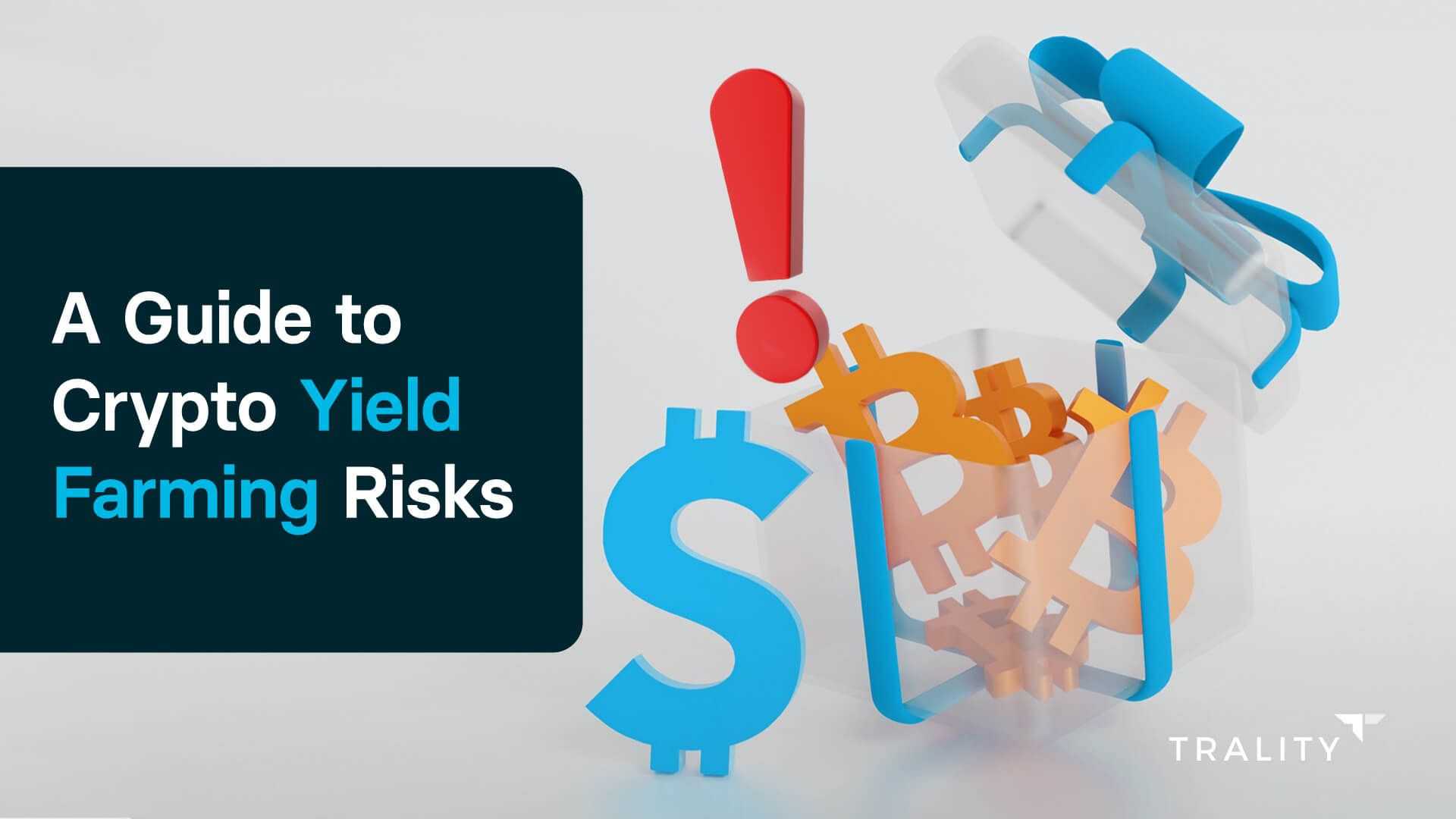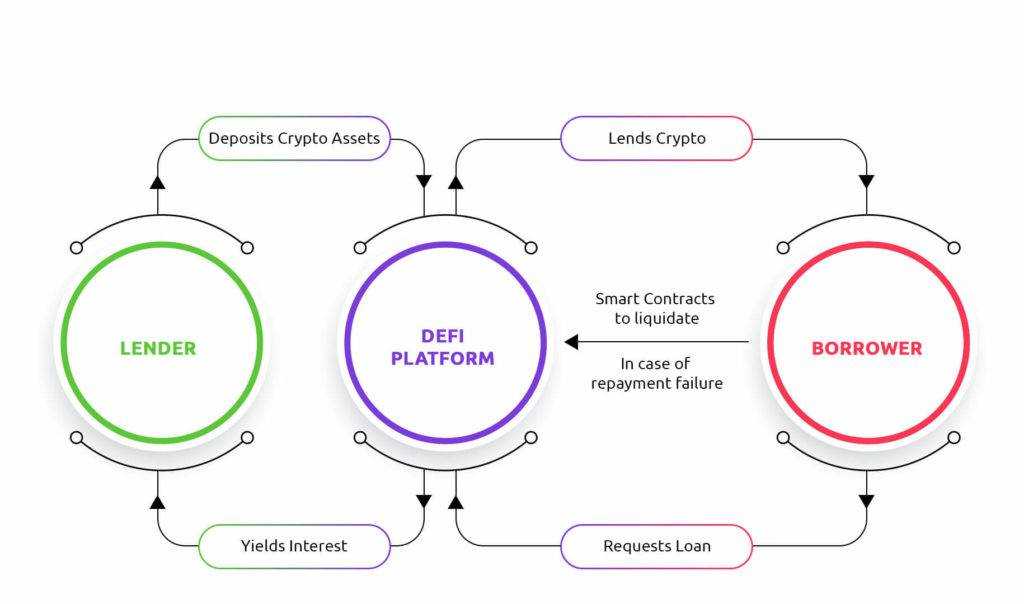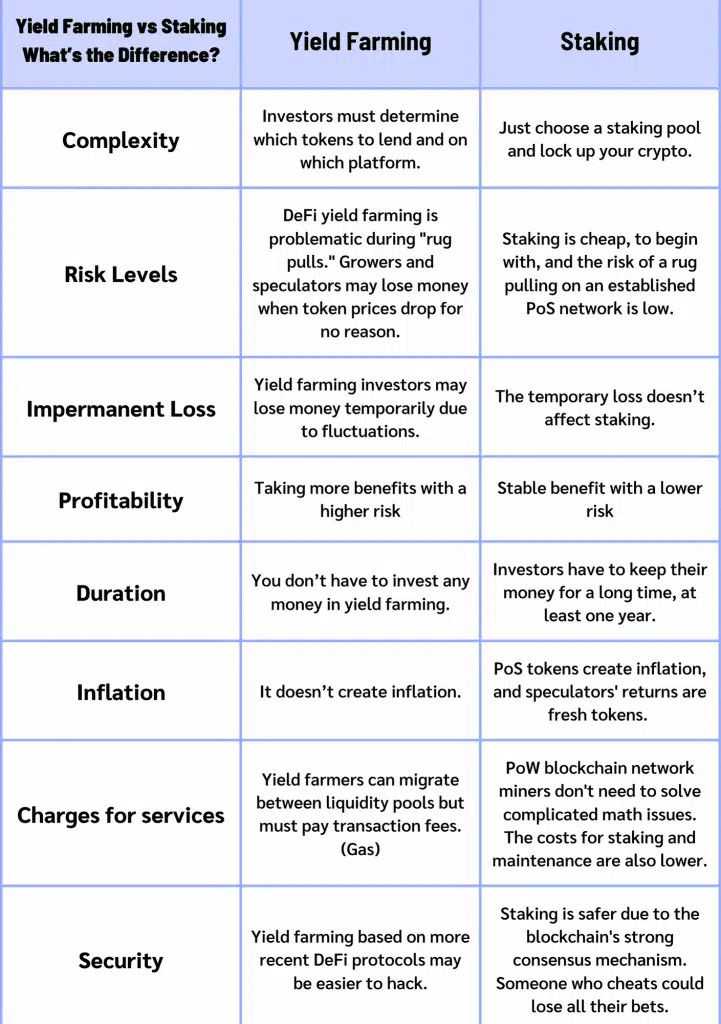A Guide to Crypto Yield Farming Risks

MORITZ PUTZHAMMER
03 April 2023 • 9 min read

Table of contents
Yield farming has emerged as a popular way for investors to earn high returns on their cryptocurrency holdings. By providing liquidity to decentralized finance protocols and participating in various yield farming strategies, investors can earn additional tokens and rewards on top of their initial investment.
However, yield farming also comes with its own set of risks, including impermanent loss and smart contract vulnerabilities, which investors should carefully consider before participating in any yield farming activity.
In the following article, we’ll look at the risks associated with yield farming before comparing it with staking. And we’ll round off the article by exploring a profitable way to earn passive income in crypto, one that mitigates the risks associated with yield farming while maximizing your potential gains.
What Is Yield Farming in Crypto?
Yield farming is a process whereby cryptocurrency investors can earn rewards for providing liquidity to decentralized exchanges (DEXs) or liquidity pools on decentralized finance platforms. Essentially, yield farmers lend their cryptocurrency holdings to these platforms in exchange for rewards, which can be in the form of additional tokens, governance tokens, or a share of transaction fees.

The crypto from yield farming is deposited in liquidity pools to provide liquidity for the protocol, ensuring seamless trading, lending, and borrowing. Note that when you deposit your crypto in a yield farm, you are essentially a liquidity provider (LP). In turn, you earn passive income from the fees earned by the DeFi protocol, even in a bear market.
You can farm your cryptocurrencies on a single DeFi platform or continuously move them around to multiple platforms to maximize their returns. This is the case because most yield farming protocols offer varying interest rates, ones which change from time to time.
Is Yield Farming Legit?
In a word: Yes. Yield farming is a legitimate way to earn cryptocurrency. Yield farming and liquidity mining works by providing liquidity to decentralized exchanges (DEXs) such as Uniswap, SushiSwap, or PancakeSwap. In return, yield farmers receive rewards in the form of native tokens or fees from the protocol. These rewards can be substantial, with some yield farming protocols offering five-figure APYs.
However, it's important to note that the high rewards come with high risks. Yield farming protocols are not regulated, meaning that there is no financial authority overseeing them. Therefore, the risks associated with yield farming can be substantial and investors need to be aware of these risks before investing.
Let’s consider a few of those risks.
What Are the Risks of Crypto Yield Farming?
Although yield farming is certainly legitimate, it can carry significant risks. Here are some of the yield farming risks.
Smart contract risk
Yield farming protocols are often built on top of smart contracts, and so it's imperative to assess the respective smart contract's security and audit history before investing. And while smart contracts are generally considered to be secure and tamper-proof, they are still susceptible to bugs and vulnerabilities. If there is a flaw in the code, it can result in a loss of funds. You should always monitor any updates or changes that are made to a protocol’s smart contract.
If a smart contract has a bug or vulnerability, it can be exploited by attackers to steal funds or manipulate the yield farming process. This could result in significant losses for investors who have deposited their crypto in the liquidity protocol. Other than direct attacks, smart contracts can also be subject to other risks, such as the risk of oracle failure or the risk of incorrect data inputs.
Impermanent loss
In yield farming, an impermanent loss is a temporary loss that liquidity providers may experience due to changes in the price of the tokens they have deposited in the liquidity pool. This loss occurs because the value of the tokens may fluctuate during the time they are locked up in the protocol, potentially resulting in a loss when they are withdrawn. Impermanent losses are not actualized until liquidity is withdrawn from the pool, and the actual loss experienced may vary depending on the change in token prices throughout the duration of liquidity provision.
Let’s take an example. Suppose you decide to provide liquidity for an ETH/DAI trading pool by depositing both tokens in a 50:50 ratio. When you make the deposit, the value of 1 DAI token is equivalent to 0.0025 ETH tokens.
You deposit 10,000 DAI and 25 ETH tokens into the pool. However, the price of ETH soon begins to soar and more people start purchasing ETH tokens in the secondary market. As a result, the protocol adjusts the ratio of your deposited tokens to maintain the 50:50 split between the two assets.
Suddenly, 1 DAI token is worth only 0.002 ETH tokens due to the spike in ETH's price. Since you initially deposited an equal value of both tokens, the Uniswap protocol automatically rebalances your holdings to keep them equal, meaning that you will end up with fewer ETH and more DAI in the pool than you had initially deposited.
If you decide to withdraw your liquidity from the pool at this point, you will have fewer ETH than you did when you started, even though the price of ETH may have since recovered. The reason behind this is impermanent loss, as the loss is only temporary and the value of your holdings may recover in the future.
Market volatility
Yield farming returns are often tied to the underlying asset's price, which can be volatile. When liquidity providers or LPs withdraw their coins from the protocols, market volatility between the time of deposit and the time of withdrawal could significantly impact the value of their crypto.
The inherently volatile nature of cryptocurrencies means that LPs are potentially exposed to significant losses. Even small fluctuations in price can dramatically impact the profitability of yield farming, especially if the investor has borrowed assets or invested in highly leveraged pools.
Regulatory risks
Regulatory risk is a potential threat to yield farming due to the decentralized nature of DeFi protocols. Because of their decentralized nature, DeFi protocols are not subject to traditional financial regulations, making them more susceptible to regulatory risk. Governments may arbitrarily crack down on DeFi protocols, as they did with crypto staking in 2023, which could limit liquidity, increase costs, and reduce profitability, making it imperative to keep abreast of regulatory developments that may impact yield farming.
Liquidity risk
Liquidity risk is an important consideration for anyone engaging in yield farming. Yield farming involves providing liquidity to DeFi protocols, but the liquidity of these tokens can vary widely depending on market conditions and the demand for the underlying assets. If liquidity dries up, it can become difficult for LPs to withdraw assets from the protocol without incurring significant slippage, potentially resulting in a loss of funds.
High gas fees
Yield farming transactions often require significant amounts of gas, resulting in high transaction fees. In yield farming, users often need to execute multiple transactions in order to participate in a protocol, such as depositing collateral, withdrawing funds, or swapping tokens. Each of these transactions incurs a gas fee, which can be expensive during times of high network congestion.
Obviously, gas fees are usually higher on most blockchains when demand is high(er). And given the popularity of yield farming, the number of transactions is increasing. These fees can erode the profitability of the yield farming strategy, particularly for small investors, which is why it’s important to keep this aspect in mind.
High gas fees significantly impact the profitability of yield farming, especially for small retail investors. If the gas fees are too high, then the cost of executing transactions may exceed the yield generated by the protocol. Additionally, high gas fees can create an uneven playing field, favoring larger investors who can afford to pay higher fees.
Unknown risks
Yield farming protocols can be complex and the risks associated with them may not be immediately apparent. For example, yield farmers may not be aware of the risks associated with the governance token, which can be subject to manipulation or centralization issues.
Rug pull scams
A rug pull scam refers to a fraudulent practice in which a project or protocol team deliberately drains liquidity or removes user funds from a project, resulting in losses for investors. In yield farming, rug pull scams can occur when a project offers abnormally high yields and attractive incentives to investors, only to have the project’s founders disappear or execute an exit scam.
These scams are a significant risk in yield farming, especially for new and unproven projects. Also, keep in mind that anyone can create a yield farming dApp for the purpose of scamming unsuspecting investors with abnormally high yields, which is why it is so important to carry out thorough due diligence before farming your crypto.
Strategy risks
As with any income-generating activity in the crypto market, strategy is a crucial consideration when it comes to yield farming. It should be noted that returns in yield farms aren’t always constant, but can vary depending on various factors, including changes in market conditions (especially demand), changes in protocol rules, or unexpected events such as hacks or exploits. Your strategy should be to maximize, as much as possible, the return from a particular yield farm, although the bed laid plans can and do go awry unpredictably.
Since it’s almost impossible to anticipate if your strategy will give a consistently higher yield, you should diversify your investments across multiple protocols. In practice, this means investing both in established and new protocols as well as experimenting with different yield farming strategies to pinpoint the best fit for your investment goals. Also, stay up-to-date with the latest market news and developments and be prepared to adjust your investment strategies accordingly.
Is Yield Farming Riskier Than Staking?
It can be. When considering yield farming vs staking, yield farming is generally considered riskier, with the most significant risk being impermanent loss. There is, however, no risk of impermanent loss in staking. Yield farming involves providing liquidity to a DeFi protocol, which carries a higher level of risk because liquidity pools create arbitrage opportunities for the greater crypto market.

Although yield farming and staking are both strategies for earning passive income in DeFi, the rewards associated with yield farming are often higher.
Is Yield Farming Crypto Still Profitable?
Despite the significant yield farming risks, yield farming crypto is still profitable. You can think of yield farming as crypto’s high-risk, high-reward strategy. Generally, LPs can switch between different protocols that offer the highest APYs in order to maximize their returns. In fact, yield farming protocols can offer thousands of annual percentage yields (APY).
However, keep in mind that the yields tend to change over time. Therefore, if you deposit your crypto into a liquidity protocol offering a 7000% APY, there’s no guarantee that it will remain the same throughout (e.g., it could very well drop to 90% APY). In the end, the profitability of yield farming comes down to your risk tolerance and chosen strategy as well as a healthy dose of luck.
Yield Farming Alternatives
Let’s say that you’re wary of the risks associated with yield farming and you’re looking for something a bit more glamorous than staking. Are there any other ways to earn passive income in crypto?
One of the easiest ways to gain exposure to the crypto market while also minimizing risk as well as the amount of time spent managing your portfolio is by renting automated investment strategies. It's basically a form of copy trading in which you effectively let expert traders do the heavy lifting for you while you sit back and evaluate the performance of their custom trading bots.
The Trality Marketplace

Trality’s Marketplace is a cutting-edge investment platform that brings together expert crypto trading bot creators and investors for mutually beneficial purposes. Unlike other platforms with anonymous bot makers and unproven bots, Trality’s Marketplace is a carefully curated space with hand-picked creators and the best bots available, making it an ideal way to explore the many benefits of earning passive income in crypto without exposing your portfolio to the crypto market’s volatility.
As an investor, you can rent profitable bots tailored to your specific risk tolerances (low, medium, and high) and individual investment goals. And each bot features a full suite of metrics, allowing you to select the appropriate bot based on quantifiable data.
Access bots that outperform the market
You’ll also receive updates in real time whenever any changes are made to a bot, giving you peace of mind when it comes to transparency. If a bot underperforms, you can simply unfollow it at any time and select another bot.
And since the crypto market is a volatile one, all bots are backtested in different market conditions such as bull, bear and sideways market regimes to ensure consistent returns. It’s this uncompromising commitment to an open bot evaluation process that distinguishes Trality’s Marketplace from generic, black-box alternatives that provide a bare minimum of relevant information.
Final Thoughts on the Risks of Crypto Yield Farming
Yield farming is a growing trend in the DeFi space, offering investors the opportunity to earn substantial rewards on their crypto assets.
However, there are always downsides to weigh when considering the various options for earning passive income in crypto. As we’ve seen, yield farming risks can be significant, which is why it is best to consider lower-risk alternatives, at least until the crypto market emerges from its winter slumber and stabilizes.
As the crypto space continues to evolve, it's likely that we will see even more innovative yield farming strategies and platforms emerge. As such, it's important for investors to stay informed about the latest developments and to always approach yield farming with caution and a comprehensive understanding of the risks involved.
Ultimately, yield farming can be a rewarding way to earn passive income in the crypto world, but it's important to do your due diligence and proceed with caution.





